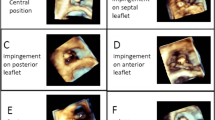Abstract
Purpose
Cardiac rhythm management devices (CRMD) require a ventricular lead to be placed across the tricuspid valve. Tricuspid regurgitation (TR) is an under-recognized clinical complication of lead implantation and its clinical significance is unknown. We studied the incidence of hospitalizations for congestive heart failure (CHF) exacerbation among patients with worsening TR after ventricular lead implantation.
Methods
We reviewed 148 patients (age 68 ± 15) that received a CRMD. TR and pulmonary artery systolic pressure (PASP) measured by Doppler echocardiography before and after CRMD implantation were analyzed. Hospitalizations for CHF exacerbation post-implantation were counted.
Results
Follow-up was 32 ± 14 months. Ninety-nine (67 %) patients had no change, 24 (16 %) slight, and 9 (6 %) significant increase in TR after CRMD implantation, while 13 (9 %) patients had slight and 3 (2 %) significant improvement. Patients with a significant increase in TR had higher incidence of hospitalizations (1.7 ± 0.5) compared to patients with slight (0.8 ± 1; p = 0.006) or no increase (0.5 ± 1; p = 0.0002) in TR. Patients with significant increase in TR had a greater change in PASP (25 mmHg; p = 0.002) after device implantation compared to those with a slight (10 mmHg; p = 0.002) or no increase (0.7 mmHg; p = 0.17).
Conclusion
Increased TR following CRMD implantation is relatively common (33 %) and correlated with subsequent risk of hospitalization for heart failure. A preventive strategy and close monitoring for development or worsening of CHF after CRMD implantation may help prevent hospital admissions.


Similar content being viewed by others
References
Morgan, D. E., Norman, R., West, R. O., & Burggraf, G. (1986). Echocardiographic assessment of tricuspid regurgitation during ventricular demand pacing. The American Journal of Cardiology, 58(10), 1025–1029.
Kucukarslan, N., Kirilmaz, A., Ulusoy, E., Yokusoglu, M., Gramatnikovski, N., Ozal, E., & Tatar, H. (2006). Tricuspid insufficiency does not increase early after permanent implantation of pacemaker leads. Journal of Cardiac Surgery, 21(4), 391–394.
Leibowitz, D. W., Rosenheck, S., Pollak, A., Geist, M., & Gilon, D. (2000). Transvenous pacemaker leads do not worsen tricuspid regurgitation: a prospective echocardiographic study. Cardiology, 93(1–2), 74–77.
Webster, G., Margossian, R., Alexander, M. E., Cecchin, F., Triedman, J. K., Walsh, E. P., & Berul, C. I. (2008). Impact of transvenous ventricular pacing leads on tricuspid regurgitation in pediatric and congenital heart disease patients. Journal of Interventional Cardiac Electrophysiology, 21(1), 65–68.
Paniagua, D., Aldrich, H. R., Lieberman, E. H., Lamas, G. A., & Agatston, A. S. (1998). Increased prevalence of significant tricuspid regurgitation in patients with transvenous pacemakers leads. The American Journal of Cardiology, 82(9), 1130–1132. A9.
Lin, G., Nishimura, R. A., Connolly, H. M., Dearani, J. A., Sundt, T. M., 3rd, & Hayes, D. L. (2005). Severe symptomatic tricuspid valve regurgitation due to permanent pacemaker or implantable cardioverter-defibrillator leads. Journal of the American College of Cardiology, 45(10), 1672–1675.
Kim, J. B., Spevack, D. M., Tunick, P. A., Bullinga, J. R., Kronzon, I., Chinitz, L. A., & Reynolds, H. R. (2008). The effect of transvenous pacemaker and implantable cardioverter defibrillator lead placement on tricuspid valve function: an observational study. Journal of the American Society of Echocardiography, 21(3), 284–287.
Klutstein, M., Balkin, J., Butnaru, A., Ilan, M., Lahad, A., & Rosenmann, D. (2009). Tricuspid incompetence following permanent pacemaker implantation. Pacing and Clinical Electrophysiology, 32(Suppl 1), S135–S137.
Vaturi, M., Kusniec, J., Shapira, Y., Nevzorov, R., Yedidya, I., Weisenberg, D., Monakier, D., Strasberg, B., & Sagie, A. (2010). Right ventricular pacing increases tricuspid regurgitation grade regardless of the mechanical interference to the valve by the electrode. European Journal of Echocardiography, 11(6), 550–553.
Zoghbi, W. A., Enriquez-Sarano, M., Foster, E., Grayburn, P. A., Kraft, C. D., Levine, R. A., Nihoyannopoulos, P., Otto, C. M., Quinones, M. A., Rakowski, H., Stewart, W. J., Waggoner, A., Weissman, N. J., & American Society of Echocardiography. (2003). Recommendations for evaluation of the severity of native valvular regurgitation with two-dimensional and Doppler echocardiography. Journal of the American Society of Echocardiography, 16(7), 777–802.
Robboy, S. J., Harthorne, J. W., Leinbach, R. C., Sanders, C. A., & Austen, W. G. (1969). Autopsy findings with permanent pervenous pacemakers. Circulation, 39(4), 495–501.
Author information
Authors and Affiliations
Corresponding author
Rights and permissions
About this article
Cite this article
Baquero, G.A., Yadav, P., Skibba, J.B. et al. Clinical significance of increased tricuspid valve incompetence following implantation of ventricular leads. J Interv Card Electrophysiol 38, 197–202 (2013). https://doi.org/10.1007/s10840-013-9826-2
Received:
Accepted:
Published:
Issue Date:
DOI: https://doi.org/10.1007/s10840-013-9826-2




